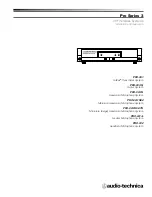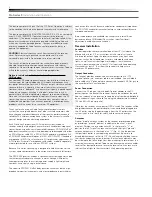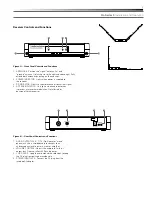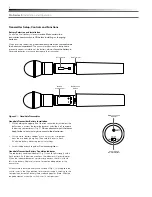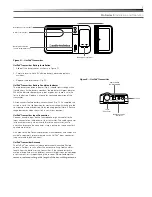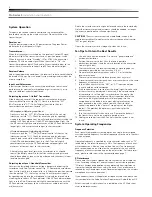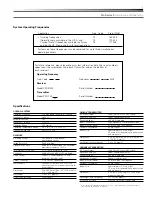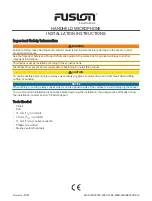
Pro Series 3
Installation and Operation
2
This device complies with part 15 of the FCC Rules. Operation is subject
to the condition that this device does not cause harmful interference.
This device complies with INDUSTRY CANADA R.S.S. 210, en conformité
avec IC: RSS-210/CNR210. Operation is subject to the following
conditions: 1) This device may not cause harmful interference and 2) this
device must accept any interference received, including interference
which may cause undesired operation. Changes or modifications not
expressly approved by Audio-Technica could void your authority to
operate this equipment.
CAUTION!
Electrical shock can result from removal of the receiver
cover. Refer servicing to qualified service personnel. No user-
serviceable parts inside. Do not expose to rain or moisture.
The circuits inside the receiver and transmitter have been precisely
adjusted for optimum performance and compliance with federal
regulations. Do not attempt to open the receiver or transmitter. To do so
will void the warranty, and may cause improper operation.
Notice to individuals with implanted cardiac pacemakers or
AICD devices:
Any source of RF (radio frequency) energy may interfere with normal
functioning of the implanted device. All wireless microphones have
low-power transmitters (less than 0.05 watts output) which are unlikely
to cause difficulty, especially if they are at least a few inches away.
However, since a “body-pack” mic transmitter typically is placed against
the body, we suggest attaching it at the belt, rather than in a shirt
pocket where it may be immediately adjacent to the medical device.
Note also that any medical-device disruption will cease when the RF
transmitting source is turned off. Please contact your physician or
medical-device provider if you have any questions, or experience any
problems with the use of this or any other RF equipment.
Thank you for choosing an Audio-Technica professional wireless
system. You have joined thousands of other satisfied customers who
have chosen our products because of their quality, performance and
reliability. This wireless microphone system is the successful result of
years of design and manufacturing experience.
Each Pro Series 3 professional VHF wireless system includes a
receiver and either a body-pack transmitter or a handheld microphone/
transmitter on a specific crystal-controlled frequency. PRO-301 UniPak
®
body-pack transmitter systems include models pre-packaged with either
an AT-GcW guitar cable (/G), a PRO 8HEcW headworn microphone (/H),
a PRO 92cW headworn microphone (/H92), a PRO 92cW-TH headworn
microphone (/H92-TH), or a lavalier mic (/L) for particular applications. All
A-T Wireless Essentials
®
microphones and cables, available separately,
are pre-terminated for use with any PRO-301 system.
Because Pro Series 3 packaging is designed to hold all versions of the
system, some compartments in the carton are intentionally left empty.
The PRO-R300 receiver includes a space-saving switching power supply
that automatically adapts to changes in mains voltage. Unlike bulky
linear power supplies, this switching power supply is lightweight and
compact; it uses only a single outlet space.
The versatile PRO-T301 UniPak body-pack transmitter has both a high-
impedance input for instruments, and a low-impedance input with bias
connection for use with dynamic and electret condenser microphones.
The PRO-T302 handheld transmitter features a unidirectional dynamic
microphone element.
Both the body-pack and handheld transmitters use internal 9-volt
batteries and have Off/Standby/On switches, input Trim (level)
adjustments and battery-save switches.
Receiver Installation
Location
For best operation the receiver should be at least 3' (1 m) above the
ground and at least 3' (1 m) away from a wall or metal surface to
minimize reflections. Keep the receiver antennas away from noise
sources such as digital equipment, motors, automobiles and neon
lights, as well as away from large metal objects. In multi-channel
systems, position receivers at least 3' (1 m) apart and keep operating
transmitters at least 6' (2 m) from the receivers to help assure
maximum RF performance.
Output Connection
The receiver provides unbalanced, aux-level output from a
1
/
4
" TS
(“mono”) phone jack; an output cable is not included. Use a shielded
audio cable with
1
/
4
" phone plug to connect the receiver’s AF Out jack to
the mixer/amplifier’s aux-level input.
Power Connection
Connect the DC plug on the included AC power adapter to the DC
power input on the back of the receiver. Secure the cord over the cord
hook on the back of the receiver, to keep the plug from being detached
by an accidental tug on the cord. Then plug the adapter into a standard
120 Volt 60 Hz AC power outlet.
(Note that the receiver has no power Off/On switch. The receiver will be
energized whenever the power adapter is connected and plugged into
the AC outlet. Unplug the power supply from the AC outlet when the
system is not in use – both for safety, and to conserve energy.)
Antennas
A novel “dipole” antenna system on the receiver improves operation
by providing a “ground” element in addition to the usual “signal”
element. Position the two antennas at 90° in the form of a “V,” or
position the left (“signal”) antenna vertically and the right (“ground”)
antenna horizontally, in the shape of an “L” (Fig. A). Use the position
that performs better in your operating environment. Be certain to
extend both antennas to their full 15" (38 cm) length by holding them at
their bases and pulling out on their caps. Both antenna elements may
be swiveled to the left and right, but do not attempt to rotate them in a
screwing/unscrewing motion. To do so may damage the antenna and/or
receiver. For best performance, locate the receiver so its antennas are
in direct line-of-sight to the transmitter’s likely operating position.

